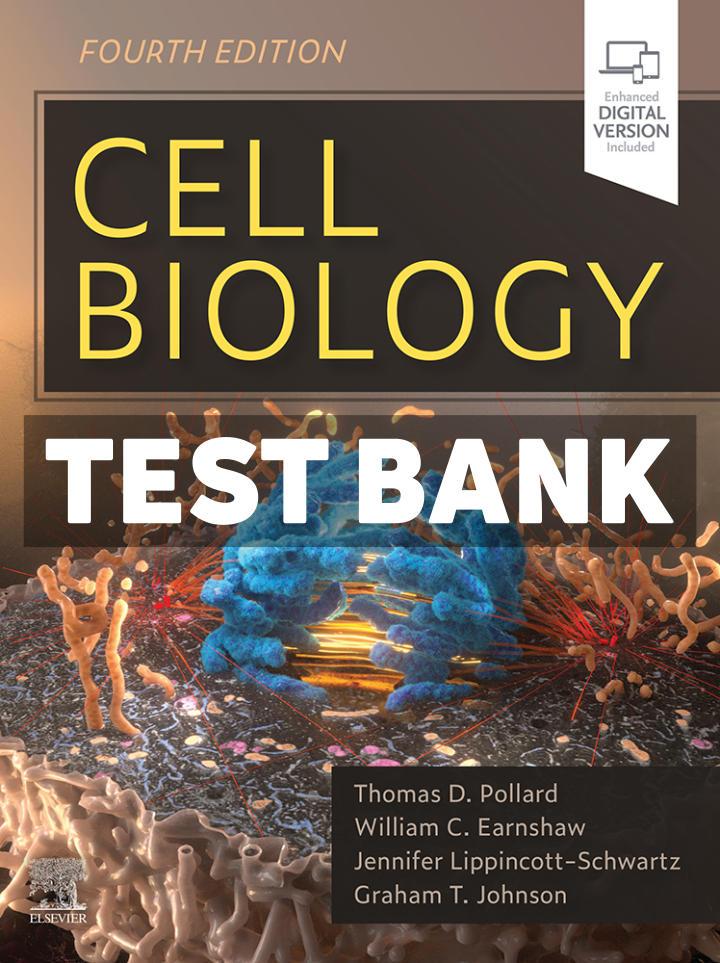

Pollard: Cell Biology, 4th Edition
Test Bank
Chapter 1: Introduction to Cells
1. About what time did the common ancestor of all life on earth live?
a.3 to 4 thousand years ago
b.3 to 4 million years ago
c.3 to 4 billion years ago
d.3 to 4 trillion years ago
Ans: C
The common ancestor lived a relatively short time after the planet formed (4.5 billion years ago).
2. What are the four nucleotides that comprise DNA?
a.Adenine, cytosine, guanine, and thymine
b.Adenine, cytosine, guano, and thymine
c.Adenine, cytoproct, guanide, and thymine
d.Adenine, cytosine, guanyin, and thymine
Ans: A All nucleotides end in “ine ”
3. What enzymes transcribe DNA into RNA?
a.RNA transcribases
b.RNAases
c.RNA polymerases
d.RNA transcriptases
Ans: C
RNA polymerases form polymers of RNA using DNA as templates.
4. Which of the following best describes the ribosome?
a.Bodies found in blackcurrants
b.Bodies that translate mRNA into polypeptides
c.Enzymes that break down proteins
d.Enzymes that break down sugars
Ans: B
Ribosomes use mRNA as templates to synthesize polypeptides
5. Cellular membranes are composed of which of the following?
a.Only proteins
b.Proteins and lipids in bilayers
c.Proteins and lipid in monolayers
d.Only bilayers of lipids
Ans: B
Membranes are composed of about equal masses of proteins and lipids, and the lipids are predominantly arranged in bilayers.
6. Which of the following statements with regard to subcellular localization of proteins is true?
a.Short sequences in proteins facilitate their passage through nuclear pores into the nucleus.
b.Short sequences in proteins facilitate their passage into the lysosome.
c.Neither of the above
d.Both of the above
Ans: D
Specific receptors recognize sequences within proteins and guide the proteins to specific locations to many different compartments within cells.
7. Which of the following statement(s) are true about eukaryotic cells?
a.Eukaryotes include bacteria, archaea, and plants.
b.Eukaryotes include animals, fungi, and protozoans.
c.Eukaryotes include animals, plants, and fungi.
d.Eukaryotes include archaea, fungi, and plants.
Ans: B and C
Bacteria and archaea are prokaryotes; the others mentioned are eukaryotes
8. Approximately when did the first eukaryotes appear?
a.3 billion years ago
b.300 million years ago
c.800 million years ago
d.1 to 2 billion years ago
Ans: D
An approximate consensus between the fossil record and molecular clock calculations is that eukaryotes arose around 1.5 billion years ago.
9. Which of the following statements is true regarding the nuclear membrane?
a.It is a single membrane that separates the cytosol from the nucleus.
b.It is a single membrane that also surrounds the nucleolus.
c.It is a double membrane that separates the cytoplasm from the nucleus.
d.It is a double membrane that separates the cytoplasm from the nucleus, and the nucleolus from the nucleus.
Ans: C
The double membrane system contains pores to allow the selective transport of material in and out of the nucleus.
10. In humans, what percentage of the 3 billion base pairs making up the genome encode proteins?
a.0.02%
b.0.2%
c.2.0%
d.20%
Ans: C
The remainder of the genome either performs regulatory functions or consists of repeated DNA sequences that have no known function.
11. What occurs to proteins within the Golgi apparatus?
a.Sugars are added to proteins.
b.RNA is added to proteins.
c.Proteins are digested.
d.Proteins are synthesized.
Ans: A
The addition of sugars to proteins is called glycosylation and is necessary for the functions of many extracellular proteins.
12. What is a protein kinase?
a.A protein that moves.
b.A protein that hydrolyses other proteins by proteolysis.
c.A protein that lyses bacteria by digesting the bacterial cell wall.
d.A protein that adds a phosphate to proteins or other molecules.
Ans: D
A kinase transfers a phosphate, usually from ATP to another protein or a lipid, or other molecule. A phosphatase reverses this phosphorylation.
